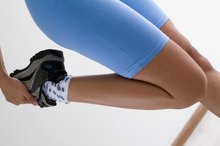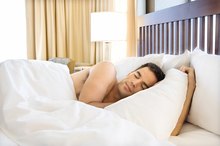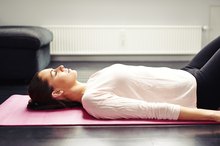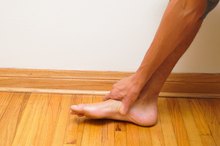What does fact checked mean?
At Healthfully, we strive to deliver objective content that is accurate and up-to-date. Our team periodically reviews articles in order to ensure content quality. The sources cited below consist of evidence from peer-reviewed journals, prominent medical organizations, academic associations, and government data.
The information contained on this site is for informational purposes only, and should not be used as a substitute for the advice of a professional health care provider. Please check with the appropriate physician regarding health questions and concerns. Although we strive to deliver accurate and up-to-date information, no guarantee to that effect is made.
How to Wear a Back Support While You Sleep
Back supports, or orthoses, are used by people rehabilitating from a back injury or surgery. The belts are intended to provide additional support while the back heals, and come in a variety of forms, ranging from cervical braces to corset-like wraps or rigid braces. Wearing a back support during the day can prevent you from twisting or turning your back while healing takes place, but wearing it while you sleep can be uncomfortable, and requires a few adjustments.
Lie down only when you must, and try to avoid the bed until you are ready to sleep at night. Even with a back brace, you need to move around as much as possible to speed your recovery, the National Institute of Neurological Disorders and Stroke advises 2. Follow the instructions of your doctor and physical therapist to find out which activities you should be doing and how long you should spend in bed.
How to Sleep in a Knee Brace
Learn More
Back up to the bed when you are ready to sleep. Sit squarely on the edge of the bed, swing both legs up onto the bed at the same time, and lie down. You might need assistance if your legs are not strong enough. The back support should prevent you from twisting when you get into bed.
Use a log roll to get into position on the bed. Tuck your knees up, and keep your head and neck aligned with your back brace so you don’t pull anything. Leave your arms out straight or tuck them close to your chest as you roll over. Once you’ve settled on the spot in which you’ll sleep, adjust pillows and blankets as desired.
How to Sleep After Rotator Cuff Surgery
Learn More
Place a pillow under your knees to release the pressure your legs can cause by pulling on the tender tendons in your back.
Sleep on your side if that’s your normal sleeping pattern, or if your doctor suggests it. Doctors at the Mayfield Clinic recommend placing a pillow between your knees once you’ve turned on your side, to stabilize your back prior to falling asleep 3.
Get out of the bed using a reverse technique. Roll over to the side of the bed, and push yourself up with your arms, then swing your legs over the side of the bed and stand up.
Tips
Call your orthotist if you have troubled sleeping in the back brace. He can provide you with extra liners to wear while sleeping, which may prevent pinching or other discomfort. Ask about a brace designed specifically for nighttime wear if you cannot sleep in your back support.
Warnings
Pay attention to irritations, rashes, or cuts caused by the support after sleeping. An open wound can become infected if not treated.
Related Articles
References
Writer Bio
Linda Ray is an award-winning journalist with more than 20 years reporting experience. She's covered business for newspapers and magazines, including the "Greenville News," "Success Magazine" and "American City Business Journals." Ray holds a journalism degree and teaches writing, career development and an FDIC course called "Money Smart."







